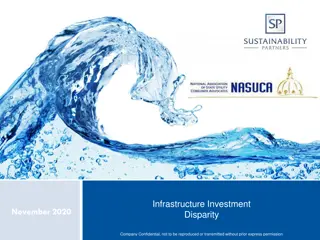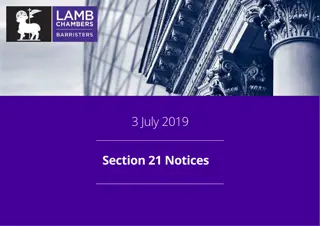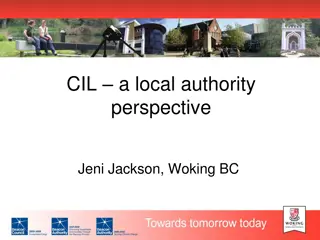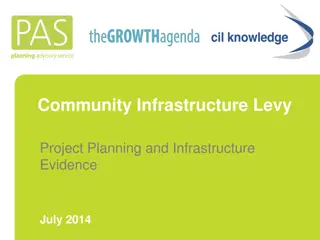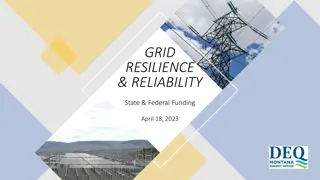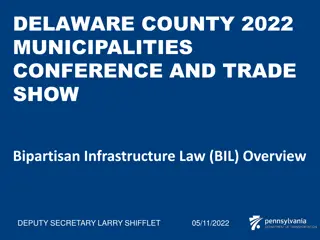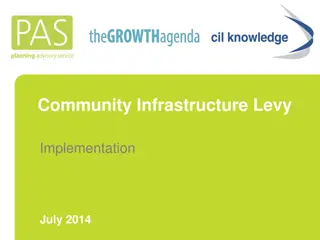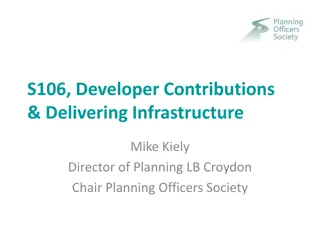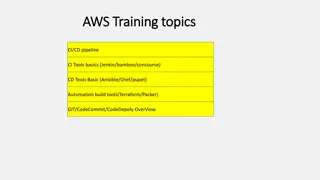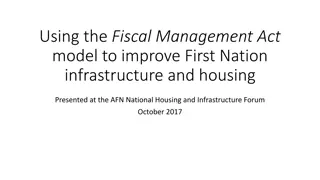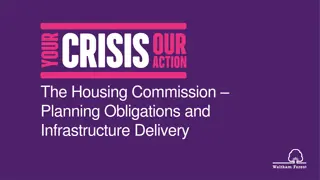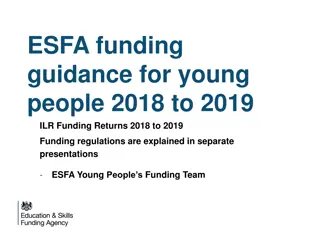Understanding CIL vs. Section 106 for Infrastructure Funding
Explore the differences between Community Infrastructure Levy (CIL) and Section 106 Planning Obligations, their implications on funding infrastructure, eligibility criteria for payment, flexibility in spending, and the need for a Reg. 123 list. Learn how CIL and Section 106 contributions impact affordable housing, infrastructure development, and viability testing at a borough-wide level.
Download Presentation

Please find below an Image/Link to download the presentation.
The content on the website is provided AS IS for your information and personal use only. It may not be sold, licensed, or shared on other websites without obtaining consent from the author. Download presentation by click this link. If you encounter any issues during the download, it is possible that the publisher has removed the file from their server.
E N D
Presentation Transcript
CIL vs S106 The Regulation 123 list ?
The Funding Pie The levy cannot be expected to pay for all of the infrastructure required: 10-30% Consider CIL as just one part of a more complex blend of funding Value Regional Growth Fund Local Government Grants Borrowing Capital reciepts Business Rate Retention CIL s106 ?
A comparison of CIL vs S106 Planning Obligations (Site specific negotiations) Community Infrastructure Levy (Charging Schedule) Scope What Type of Infrastructure can it support? Only items justifiable within the 3 legal tests: a) necessary to make the development acceptable in planning terms b) directly related to the development c) fairly and reasonably related in scale and kind to the development Yes - use to prescribe a proportion of affordable housing contributions All infrastructure necessary to support development of the area Can it be used to secure Affordable Housing? No Geographic Application Site specific impacts that may or may not reach beyond the red line Must cover whole Planning Authority Area with no exceptions (room for differential rates) Any development over 100m2 Building that people would normally go into. (some further exemptions existing for charities and social housing) Capital & Revenue for ongoing maintenance What types of development are eligible to pay CIL? All development (but the time consuming nature of the process means only the largest are charged) Eligibility of Capital & Revenue Capital & Revenue both eligible (Revenue for maintenance & agreed revenue items) Can the money be pooled? Not for long. After April 2014 you will not be able to collect s106 contributions from 5 or more developments CIL is effectively a pooling mechanism with complete flexibility over spending priorities Once the money is collected how easy is to change what it is spent on? Is there a need to establish a list of Infrastructure requirements Items agreed within the s106 Agreement (this is often inflexible). It cannot be spend on items identified for CIL investment The authority needs to justify s106 is necessary based on the 3 legal tests (as above) CIL can be spent on any infrastructure. Authorities need to set out the items they intend to fund using CIL in a Reg 123 list. Yes. Need costed infrastructure list to prove local need (there is no emphasis on prioritisation at the evidence gathering stage and explicit recognition that the list will change over time) Differences in rates should only relate to viability in different zones or of different uses (not infrastructure costs or the impact of a proposed development) Setting Charging Levels Setting differential rates Negotiated proposal taking each development on its merits Per m2 of additional floor space only (all uses) Charging Units Flexible Testing Viability Case by case basis (leaving room for negotiation during pre-application discussion) Viability is tested at a borough-wide level at the evidence gather stage, then CIL payments are mandatory ?
Purpose of the Reg 123 list double dipping is a concern for Developers Regulation 123 is the requirement for a published list of infrastructure projects or types of infrastructure that the Charging Authority intends will be, or may be, wholly or partly funded by CIL, those infrastructure projects or types of infrastructure. put another way you cannot collect s106 to spend on items within your Reg 123 list ?
123 Golden Thread Devising it: A draft Reg 123 list will now be part of the examination Post Examination: should be based on the draft list examined with the charging schedule Need to explain the reason for change Appropriate local consultation Where a change to the regulation 123 list would have a significant impact on viability evidence requires a review of the charging schedule Relevant Plan Infrastructure Evidence CIL Infrastructure Evidence Funding Gap Project List Regulation 123 List ?
s106 Obligations When a charging authority introduces the Community Infrastructure Levy, section 106 requirements should be scaled back to those matters that are directly related to a specific site, and are not set out in a regulation 123 list 3 legal tests: a) necessary to make the development acceptable in planning terms b) directly related to the development c) fairly and reasonably related in scale and kind to the development Planning Obligations can be secured through: In-kind and financial contributions e.g. through the provision of land and facilities, or funds On-off payments and phased payments, and maintenance payments Pool contributions Unilateral undertakings by developers the applicant undertaking to the Authority to deal with specific planning issues before planning permission is granted ?
s106 Obligations Planning Obligations may be: Unconditional or subject to conditions Positive, requiring the developer to do something Negative, restricting the developer from doing something Relate to specific financial payments based on formula and often referred to as commuted Timing is important : If a planning obligation specifies a timescale within which the developer is required to undertake certain actions If the planning permission refers to the phasing of development, the planning obligation may be linked to this phasing arrangement If the planning obligation is a commuted sum are the money must be spent within a specified period. ?
Expenditure @ the Examination 1. Infrastructure Evidence: What, Where, How it will be funded 2. Viability evidence CIL & s106 as a development cost The extent to which s106 targets have been met (performance on Affordable Housing & the performance of tariffs) 3. Regulation 123 List intentions for your CIL receipts 4. How s106 policies will be varied A draft Supplementary Planning Document? ?
Planning Obligations Approach When to use s106? When to use CIL? (not to forget alternative funding sources) Recognition of delivery mechanisms Local context Affordabl e Housing Objective s Strategic Sites vs Small Sites Planning Obligations Strategy CIL Developme nt market Technical Viability ?
Implications on Council Resources Education Transport Community Facilities Green space Health Education Transport Education The greater demand on and for Council resources to deliver ?
Exercise 2 Discuss in small groups the particular challenges in your Councils that you will face in producing a draft regulations 123 list and position on s106. Specifically, consider What will your Reg 123 list cover? What will your s106 position statement be? What is the internal process you need to go through to agree this before Examination? ?




